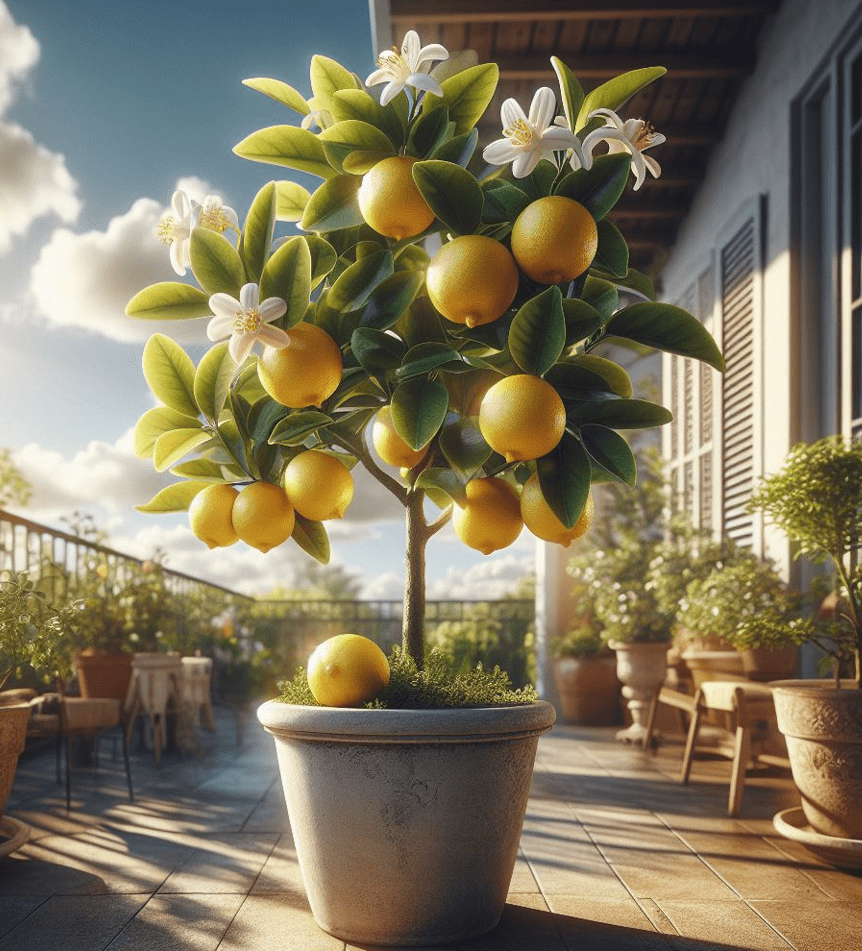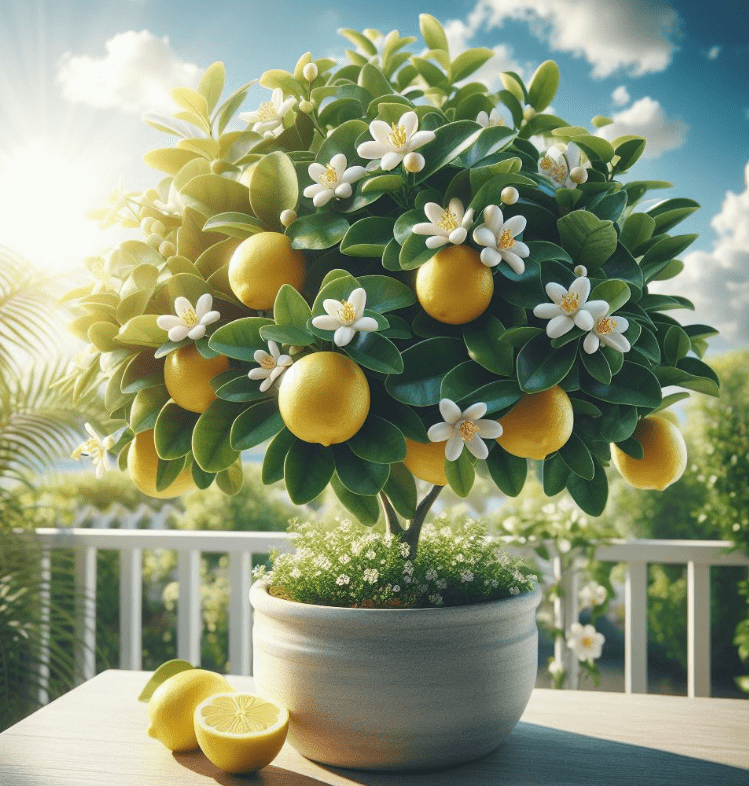
Grow your own Meyer lemon tree for a refreshing and rewarding experience. These citrus trees produce sweet, flavorful lemons for lemonade, lemon curd, and other culinary creations. With proper care, Meyer lemon trees can thrive in various climates, from warm to cool.
And what if you could have the freedom to grow your supply of these beloved fruits right in your backyard or indoors?
Enter Meyer lemon trees, a hybrid variety that offers a delightful balance of sweetness and acidity, making them prized for their versatility and ease of cultivation. Whether you’re a seasoned gardener or a novice green thumb, growing Meyer lemon trees can be a rewarding experience.
Unveiling the Allure of Meyer Lemons
Meyer lemon trees, a cross between Mandarin and Lisbon lemons, are known for their sweet, flavorful, and aromatic fruits. Unlike their tarter cousins, Meyer lemons are generally more cold-tolerant, making them suitable for cultivation in a broader range of climates.
Besides their culinary appeal, Meyer lemon trees add elegance and charm to any garden or indoor setting. Their delicate white flowers, blooming in spring, are a delightful sight, followed by lush, vibrant green foliage that provides a splash of color throughout the year.
From Grafted to Seed-Grown: Selecting Your Meyer Lemon Tree
Choosing a healthy and well-established plant from a reputable nursery or online source is crucial when embarking on your Meyer lemon tree journey. Two main options are available: grafted and seed-grown trees.
Grafted Meyer Lemon Trees:
Grafted trees offer a faster and more reliable fruit-bearing experience. The rootstock, a vigorous and hardy variety, provides stability and structural support, while the scion, the upper portion of the tree, imparts the desirable characteristics of the Meyer lemon variety.
Seed-Grown Meyer Lemon Trees:
Seed-grown trees may take longer to mature and produce fruit, but they have the advantage of being true to their parentage, meaning they will produce lemons identical to the fruit from which the seeds were taken.
Finding the Perfect Spot for Your Meyer Lemon Tree
Choosing an ideal location for your Meyer lemon tree is essential for its optimal growth and development. Here are some key considerations:
Well-Drained Soil:
Meyer lemon trees prefer well-draining, slightly acidic soil to avoid waterlogging and root rot. Amend the soil with organic matter, such as compost or aged manure, to improve drainage and nutrient content.
Full Sun Exposure:
Meyer lemon trees thrive in full sun, receiving at least six hours of direct sunlight daily. Adequate sunlight is crucial for photosynthesis, the process by which the tree produces energy and grows strong and healthy.
Good Air Circulation:
Ensure your Meyer lemon tree has good air circulation to prevent diseases and pests. Avoid planting it in enclosed spaces or close to tall structures that can obstruct airflow.
Container or Ground Planting: Adapting to Your Space
The method of planting your Meyer lemon tree depends on your climate and available space.
Container Planting:
Container planting is a versatile option for gardeners in colder climates or those with limited outdoor space. Choose a large, sturdy container with drainage holes and use a well-draining potting mix specifically formulated for citrus trees.
Ground Planting:
Ground planting is viable if you live in a warmer climate with ample outdoor space. Select a planting site that receives full sun and has well-draining soil. Consider the mature size of your Meyer lemon tree when choosing a planting location.

Planting Your Meyer Lemon Tree: A Step-by-Step Guide
Once you’ve selected your Meyer lemon tree and chosen the planting method, follow these steps to ensure a successful transition into its new home:
Prepare the Planting Site:
Dig a hole slightly larger and deeper than the root ball of your Meyer lemon tree. Amend the soil with organic matter to improve drainage and nutrient content.
Remove the Tree from its Container:
Gently loosen the roots of your Meyer lemon tree if it’s grown in a container. If the plant is root-bound, gently tease the roots apart to encourage new growth.
Position the Tree in the Hole:
Place the tree in the hole, ensuring the graft union (the swollen area where the rootstock and scion are joined) is above the soil line. Backfill the hole with soil, tamping it firmly around the roots.
Watering and Mulching:
Water the tree thoroughly to settle the soil around the roots. Apply a layer of organic mulch, such as bark chips or wood shavings, to conserve moisture, suppress weeds, and regulate soil temperature.
Caring for Your Meyer Lemon Tree
Proper care is essential for your Meyer lemon tree to thrive and produce bountiful crops. Here’s a guide to maintaining its health and vitality:
Watering:
Water your Meyer lemon tree regularly, especially during the warm, dry months. Allow the top inch of soil to dry out between waterings. Avoid overwatering, as this can lead to root rot.
Fertilizing:
During the growing season, from spring to fall, fertilize your Meyer lemon tree every four to six weeks. Use a balanced citrus fertilizer, following the instructions on the label.
Pruning:
Pruning helps maintain your Meyer lemon tree’s shape, size, and health. Remove dead, diseased, or damaged branches, and thin out overly crowded areas to improve air circulation and light penetration. Prune after the fruit harvest in winter.
Overwintering (if applicable):
If you live in a colder climate, protect your Meyer lemon tree from freezing temperatures during the winter. If container-grown, move the tree to a sheltered location indoors or a frost-free greenhouse. If ground-planted, wrap the trunk and branches with burlap or frost blankets.
Harvesting and Enjoying Your Meyer Lemons
Meyer lemons are typically ripe when they are fully yellow and have a slight gloss. Harvest them by using a sharp knife or pruning shears to cut the fruit from the stem. Leaving a short stem attached helps preserve the fruit’s flavor and freshness.
Culinary Delights:
Incorporate your Meyer lemons into a variety of culinary creations, from refreshing lemonade and zesty lemon curd to vibrant lemon meringue pies and flavorful lemon chicken dishes.
Storage Options:
Store Meyer lemons at room temperature for up to two weeks or in the refrigerator for up to two months. For extended storage, freeze the lemons by slicing or juicing them and storing them in airtight containers or freezer bags.
Troubleshooting Common Problems and Pests
While Meyer lemon trees generally resist pests and diseases, some problems may occasionally arise. Here’s how to address common issues:
Yellowing Leaves:
Yellowing leaves can indicate various problems, such as underwatering, overwatering, nutrient deficiency, or pests. Check the soil moisture level, adjust the watering schedule, and fertilize regularly. If pests are the cause, use an appropriate insecticide or insecticidal soap.
Curling Leaves:
Curling leaves may be due to low humidity, underwatering, or pests. Increase humidity by placing the pot on a pebble tray filled with water or misting the leaves regularly. Ensure adequate watering and monitor for pests.
Leaf Drop:
Unseasonable cold temperatures, severe root damage, or underwatering can cause leaf drop. Protect the tree from cold drafts, check the root health, and adjust the watering schedule.
Fruit Drop:
Overfertilization or high soil moisture can lead to fruit drop. Adjust the fertilizer amount and ensure proper drainage.
Fruit Splitting:
Sudden changes in temperature or excessive watering can cause fruit splitting. Avoid exposing the tree to sudden temperature fluctuations and maintain consistent watering practices.
Scale:
Scale insects are pests that attach themselves to the bark or leaves of the tree and suck the sap. Remove scale insects by hand or with a horticultural oil or neem oil spray.
Aphids:
Aphids are small, sap-sucking insects that can cause leaves to curl and discolor. Treat aphid infestations with insecticidal soap or a mild solution of water and dish soap.
Mealybugs:
Mealybugs are white, cottony insects that can damage the leaves and fruits of the tree. Remove mealybugs with a cotton swab dipped in rubbing alcohol or treat with an insecticide or insecticidal soap.
Whiteflies:
Whiteflies are small, moth-like insects that feed on the undersides of leaves. Treat whitefly infestations with insecticidal soap or a systemic insecticide.
Rust Mites:
Rust mites are tiny insects that cause yellow, orange, or reddish spots on the leaves. Control rust mites with an acaricide or insecticidal soap.
Prevention and Monitoring:
Regularly inspect your Meyer lemon tree for signs of pests or diseases. Maintain good hygiene practices, avoid overwatering, and provide the tree with proper care to minimize the risk of problems.
Conclusion
Growing your own Meyer lemon tree offers a rewarding and satisfying experience, allowing you to enjoy fresh, flavorful lemons in your kitchen and appreciate the beauty of a thriving citrus tree. Following these simple care tips, you can nurture your Meyer lemon tree to produce bountiful crops and become a source of culinary inspiration and household delight. So, embrace the challenge of cultivating your sweet and tangy citrus haven, and savor the endless possibilities that Meyer lemon trees bring to your home.






















